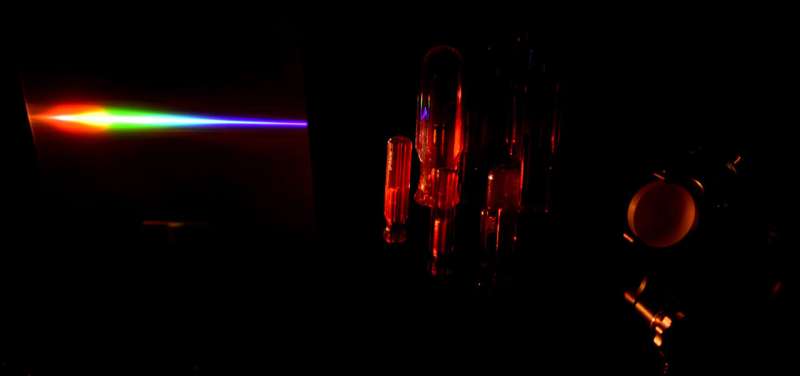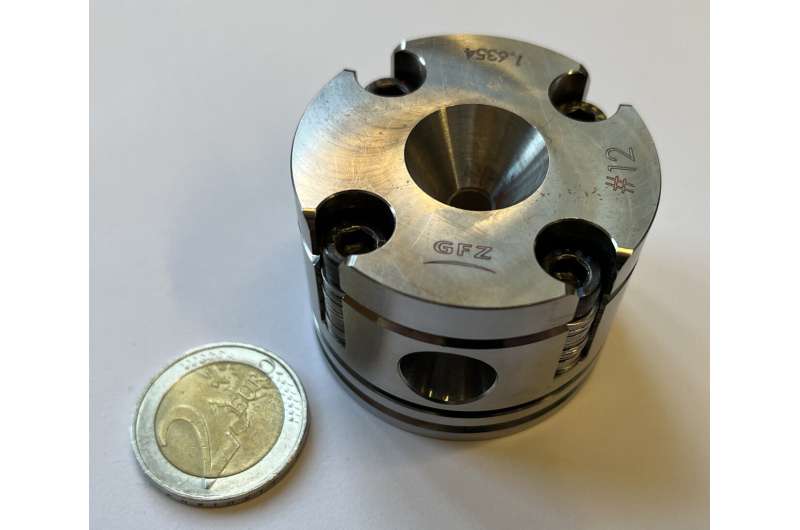How to look thousands of kilometers deep into the Earth

Researchers led by Sergey Lobanov from the GFZ German Research Centre for Geosciences have developed a new method to measure the density of silicon dioxide (SiO2) glass, one of the most important materials in industry and geology, at pressures of up to 110 gigapascals, 1.1 million times higher than normal atmospheric pressure. Instead of employing highly focused X-rays at a synchrotron facility, they used a white laser beam and a diamond anvil cell. The researchers report on their new and simple method in the current issue of Physical Review Letters.
In geosciences, the density of minerals, rocks, and melts at pressures up to several million atmospheres and temperatures of several thousand degrees is of critical importance because it governs the long-term planetary evolution as well as volcanic processes. But how can the density of a material be measured at such extreme conditions? To answer this question for a crystalline mineral or a rock, scientists use X-ray diffraction with which one measures the spacing between the periodically arranged atoms. There is, however, a problem if the material has a disordered structure, i.e. is non-crystalline, like glasses or molten rocks. In this case, the volume of the sample has to be measured directly—the density of a material equals its mass divided by volume. However, such measurements are extremely difficult because of the tiny volume of the sample brought to high pressure. Previously, these measurements required large scale X-ray facilities and highly specialized equipment, thus being very expensive. Now, a team led by scientist Sergey Lobanov of the GFZ German Research Centre for Geosciences is introducing a new method in which a laser the size of a shoebox allows them to measure the volume of samples brought to pressures similar to that at the depth of more than 2000 km in the Earth.
Inside the Earth, the rock is under unimaginably high pressure, up to several million times higher than normal atmospheric pressure. However, contrary to widespread belief, the Earth’s mantle is not liquid, but solid. The rock behaves in a viscoplastic fashion: It moves centimeter by centimeter per year, but it would burst under a hammer blow. Nevertheless, the slow movements drive the Earth’s crustal plates and tectonics, which in turn trigger volcanism. Chemical changes, for example, caused by water squeezed out of subducted crustal plates, can change the melting point of the rock in such a way that suddenly molten magma is formed. When this magma makes its way to the Earth’s crust and to the surface, volcanic eruptions occur.
Density of disordered materials
No instrument in the world can penetrate the Earth’s mantle to study such processes in detail. Therefore, one must rely on calculations, seismic signals and laboratory experiments to learn more about the Earth’s interior. A diamond anvil cell can be used to generate the extremely high pressures and temperatures that prevail there. The samples explored in it are smaller than the tip of a pin. Their volume is in the sub nanoliter range. When material is compressed under such high pressures, the internal structure changes. To analyze this precisely, X-rays are used on crystals to generate diffraction patterns. This allows conclusions to be drawn about the volume of the crystal lattice and thus also the density of the material. Non-crystalline materials, such as glasses or molten rocks, have so far kept their innermost secrets to themselves. This is because for disordered materials X-ray diffraction does not provide direct information on their volume and density.

Simple trick: Measurement with laser instead of X-ray beam
Using a simple trick, researchers led by Sergey Lobanov have now succeeded in measuring the refractive index and density of silicon dioxide (SiO2) glass, one of the most important materials in industry and geology, at pressures of up to 110 gigapascals. This is a pressure that prevails at a depth of more than 2,000 kilometers in the Earth’s interior and is 1.1 million times higher than normal atmospheric pressure. The researchers used a multicolor laser to measure the brightness of its reflection from the pressurized sample. The brightness of the laser reflection contained information on the refractive index, a fundamental material property that describes how light slows down and bends as it travels through the material, but also the path length of the laser inside the sample. Materials with a high refractive index and density, such as diamonds and metals, typically appear bright and shiny to our eye. Instead of looking at the tiny samples with a naked eye, Lobanov and his colleagues used a powerful spectrometer to record changes in brightness at high pressure. These measurements yielded the refractive index of SiO2 glass and provided key information to quantify its density.
Significance of the density measurement of glasses for the geosciences
“Earth was a giant ball of molten rock 4.5 billion years ago. To understand how Earth has cooled and produced a solid mantle and crust, we need to know the physical properties of molten rocks at extreme pressure. However, studying melts at high pressure is extremely challenging and to circumvent some of these challenges geologists choose to study glasses instead of melts. Glasses are produced by quickly cooling hot but viscous melts. As a result, the structure of glasses often represents the structure of melts they were formed from. Previous measurements of glass density at high pressure required large and expensive synchrotron facilities that produce a tightly focused beam of X-rays that can be used to view the tiny sample in a diamond anvil cell. These were challenging experiments and only the densities of very few glasses have been measured to a pressure of 1 million atmospheres. We have now shown that the evolution of the sample volume and density of any transparent glass can be accurately measured up to pressures of at least 110 GPa using optical techniques,” Lobanov says. “This can be done outside of synchrotron facilities and is therefore much easier and less costly. Our work thus paves the way to future studies of glasses that approximate Earth’s present-day and long-gone melts. These future studies will provide new quantitative answers about the evolution of the early Earth as well as the driving forces behind volcanic eruptions.”
New possibilities for the investigation of non-crystalline, initially non-transparent solids
Because the samples are extremely small and therefore ultra-thin, even materials that look like a lump of rock in large pieces become translucent. According to the researchers, these developments open up new possibilities for studying the mechanical and electronic properties of non-crystalline solids that appear nontransparent in larger volumes. According to the authors of the study, their findings have far-reaching implications for materials science and geophysics. In addition, this information could serve as a benchmark for computational studies of the transport properties of glasses and melts under extreme conditions.
Lobanov emphasizes that this kind of study was only made possible by the collegial environment at the GFZ. He heads a Helmholtz Young Investigator Group called CLEAR in the “Chemistry and Physics of Geomaterials” section. “Our experimental capabilities to probe samples at high pressure is only one thing,” says Lobanov, “at least as important were the discussions with colleagues in other sections, which helped me develop the ideas and implement them.”
Evidence of superionic ice provides new insights into the unusual magnetic fields of Uranus and Neptune
Sergey S. Lobanov et al, Electronic, Structural, and Mechanical Properties of SiO2 Glass at High Pressure Inferred from its Refractive Index, Physical Review Letters (2022). DOI: 10.1103/PhysRevLett.128.077403
Citation:
How to look thousands of kilometers deep into the Earth (2022, February 21)
retrieved 22 February 2022
from https://phys.org/news/2022-02-thousands-kilometers-deep-earth.html
This document is subject to copyright. Apart from any fair dealing for the purpose of private study or research, no
part may be reproduced without the written permission. The content is provided for information purposes only.
For all the latest Science News Click Here
For the latest news and updates, follow us on Google News.

